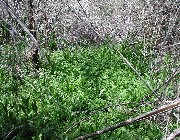
Following the discovery of gold in the upper John Day River in the early 1860s, settlement by non-native people has brought major and subtle changes to the basin. The development of hay meadows in the river bottoms removed many cottonwood stands. Sheep and cattle ranches brought large numbers of animals to the range while timber mills harvested the forests on the surrounding mountains. Settlers also brought weeds with them, which today quietly brought their own changes to the area. As the grass communities along the lower hills were impacted by heavy and often yearlong grazing, cheatgrass was able to gain a foothold and to outcompete the remaining grasses. While most native grasses are dormant, cheatgreass germinates in the autumn, grows rapidly in the spring, and produces a prodigous amount of seed. Cheatgrass has been joined by weeds such as Dalmation toadflax, whitetop, various knapweeds and thistles, yellow star-thistle, medusahead rye, poison hemlock, Russian olive, and many more. The river and stream corridors act as natural conduits for the seed, along with spread from their use by rodents and birds. Removed from their native habitats (including pests and diseases) these plants are able to flourish here unchecked, displacing native vegetation. Although the John Day Fossil Beds primarily consists of healthy, native plant communities, there are areas in each unit that have been impacted by historic grazing, or where unwanted invasions have crept up from waterways. Currently cheatgrass, toadflax, knapweeds, and medusahead rye are the most established and toughest to keep under control within monument boundries. Monument staff is taking an active role in controlling the invasion of most of the species through the development of an Integrated Pest Management (IPM) plan. Efforts at locating and controlling new infestations and maintaining or re-establishing healthy, native plant communities are underway. Impacts from other introduced species such as smallmouth bass, bullfrogs, and chukar partridges have not been studied, but may also be impacting other important resources of the monument. |
Last updated: February 28, 2015
